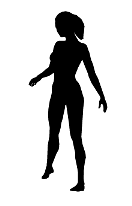
I found an interesting example, on a simple scale, of what happens (as the passage from KTS pp. 423-4 describes) when subject and distance dissolve in intimacy and the object understands itself:
“As the act of knowing unfolds, the image also projects itself into those patterns, contributing the direct ‘feedback’ of immediate experience.  In this sense, the image of the object can be said to understand itself, in a process that develops sequentially in accord with ‘feedback’ and repetition. The object in being known reflects the interpretive structure that knows it; the subject in knowing the object is modified by the object it knows.”
At the website below, there is a silhouette of a spinning figure that can appear to move clockwise or in the opposite direction spontaneously.
http://www.michaelbach.de/ot/sze_silhouette/index.htmlÂ
When I first encountered the spinning figure it was with a sense of curiosity (openness). You may see it spin one way for awhile, and if you maintain your view, you may find it suddenly changes direction without any effort (by a controlling self). It’s as if the view just flicks to a reversal, and can suddenly flick back to the opposite direction. There is something going on that the self is not initially controlling. Once you become familiar with what triggers the reversal, then the self becomes more assertive in the process.
At the bottom of the web page there is a link to the author’s experiments regarding this. The author of the site says:
…all silhouettes are ambiguous. In the case of ambiguous figures, the perceptual process takes longer compared to unambiguous figures. Our brain tries to reconstruct the third dimension (space) from the flat image in our eyes, adding information which is usually realistic, but not really there. And in the case of a silhouette, there are two equally likely interpretations. Spontaneous perceptual reversals happen although the stimulus itself stays unchanged. The author suggests that neural satiation in the early visual processing occurs, and that a lack of an external time reference contribute.
I found this fascinating because it seems to mirror my experience when I look at something and say, “This too is ‘I’.” Narrow edges drop away, openness abounds. What I am experiencing seems to touch itself on different levels beyond what I would normally narrow down and control. There is sometimes, if I am very calm, a feeling of relinquishing a position and a sense of helplessness due to an inability to keep up with the speed of the near spontaneous flickering back and forth, and so I let go, or tighten up my focus. If I let go there is that experience of intimacy. Things seem to happen on their own… something loosely analogous to a spontaneous perceptual reversal.
David
